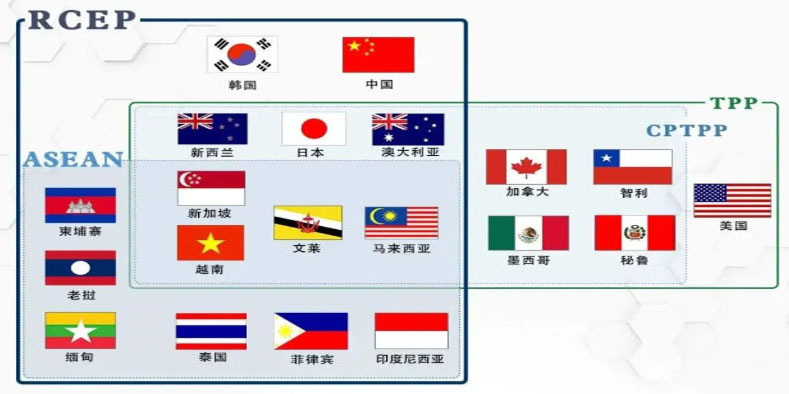
The signing of the Regional Comprehensive Economic Partnership, or RCEP, received positive reviews. Asian stock markets welcomed it with rises across the board. Australia and New Zealand, with their advantages in natural resources, agriculture and animal husbandry, seemed reassured as they joined the world’s largest economic network in East Asia. Japan and South Korea are relieved to have moved beyond their own FTA talks, which had stalled in November 2004. China, Japan and South Korea are quite happy to accept the benefits of greater connectivity in a wider geographical area.
The RCEP is open to the world, and Asia remains an open continent. No longer does anyone believe Barack Obama’s argument that without the Trans-Pacific Partnership China would establish trade rules in Asia that exclude American companies. The RCEP is obviously not a geopolitical framework.
The RCEP originated from an awareness the need for regional cooperation after the East Asian financial crisis in 1997 and conforms to the trend of regional cooperation. China, which has been actively integrating itself into the global economic system, respects the central position of ASEAN and the diversity of development across the region. It has happily accepted the 10+3 mechanism as the main cooperation channel and actively joined and promoted the in-depth development of regional economic cooperation.
After eight years of exploration, study and growth, the RCEP negotiating parties no longer look to the TPP, with its burdensome provisions, as a model template. They decided not to use the proposed institutions to restrain the weaker parties, preferring instead to allow one another a sufficient level of comfort through mutual respect and inclusive development, based on a recognition of the varying levels of development, diversity and differences in East Asia.
Compromises were actively sought on tariffs, and a generally acceptable range was agreed upon. This approach resulted in wide approval.
Unlike the European Union or the North American Free Trade Agreement, the RCEP emphasizes autonomous and inclusive development, mutual enabling, respect for each other’s choices and varying levels of comfort, so that a regional development community will naturally emerge in the world economic system, rather than forcing regional integration on all parties.
The RCEP covers 15 countries that reflect great complexity and diversity. There are developed countries with a per capita GDP of tens of thousands of dollars, as well as developing countries with less than a few hundred dollars of GDP per capita. Some economies rely on natural resources and some on high-end manufacturing. And then there is China, with its mature industrial system, large population and huge market.
The RCEP has the world’s largest pool of young workers and engineers, as well as the most dynamic and comprehensive industrial division of labor. There are world-class international business and financial centers, huge and profound education systems, rich cultural diversity and a tradition of interdependence, mutual learning and complementarity.
The RCEP members are each other’s markets and resources for development. Intraregional trade has been growing rapidly. The region features frequent investment exchanges, as well as interdependent, open and unblocked industrial chains, value chains and supply chains.
China-Japan trade is the epitome of interdependence and complementarity within the RCEP framework. At the level of the major category of imports and exports, the two countries have a horizontal division of labor — that is, goods of the same category flow in two directions.
Take machinery, for example. According to the Japanese Ministry of Finance, in September 2020 general machinery and electrical machinery accounted respectively for 21.8 percent and 20.6 percent of Japanese exports to China and 19.5 percent and 26.8 percent of in its imports from China. The shares were quite close, and trade between the two countries was fairly balanced. By comparison, passenger cars accounted for 31.8 percent of Japanese exports to the U.S. and only 1.4 percent of its imports from the U.S., presenting a serious imbalance.
In the process of business exchanges between China, Japan, South Korea and ASEAN, an industrial division of labor system has developed. Manufacturing clusters have emerged, and closely linked regional industrial and supply chains function smoothly, with regional efficiency and value distribution that benefit all parties involved.
The RCEP marks the emergence of rules of origin for the whole region. As a precondition of tariff reduction, the products of different countries now have “attributes of the same origin” and mutually recognized “geographical indications.” In other words, the 15 countries may select, purchase and export goods within the vast Asia-Pacific region without fear of dependence on or the absolute influence of any one party. The large and diverse markets will allow extensive risk diversification. Tariff concessions will directly reduce intraregional trade costs, enhance the region’s comparative advantages, expand trade and improve social well-being.
The RCEP features mutual respect, inclusion and cooperation. While providing tariff concessions, the pact also covers new topics, such as health and phytosanitary measures, standards, technical regulations, trade remedies, trade in services, movement of persons, investment rules, intellectual property, e-commerce, small and medium-sized enterprises, mutual recognition and government procurement and dispute resolution with a view toward setting unified standards and increasing compatibility.
As the largest economic cluster in the region, China, Japan and South Korea have developed in parallel, with a spillover effect on the regional economy. They will serve as the engine for dual circulation in East Asia. An inclusive and tolerant RCEP has a true potential to develop into an open, inclusive and interconnected market, with a population of potentially 3.5 billion that has the capacity to decide on technologies and their standards.
